Managing Business Project: Nestle's Training, Recruitment, Selection
VerifiedAdded on 2021/02/19
|30
|5731
|18
Project
AI Summary
This project report is a case study on Nestle, focusing on its training, selection, and recruitment methods to meet the demands of the international marketplace. The report begins with an introduction to globalization and its impact on businesses, followed by the aims, objectives, and research questions. A literature review explores concepts of training, recruitment, and selection, along with the methods adopted by Nestle and issues faced by managers. The project management plan includes scope, cost, quality, communication, time, resources, and risk assessment. The methodology section covers both quantitative and qualitative research methods, including primary and secondary data collection. The report also includes a Gantt chart and work breakdown structure. The student uses a questionnaire to collect data. The report's findings are then used to provide recommendations to Nestle.

Managing a Successful
Business Project
Business Project
Paraphrase This Document
Need a fresh take? Get an instant paraphrase of this document with our AI Paraphraser
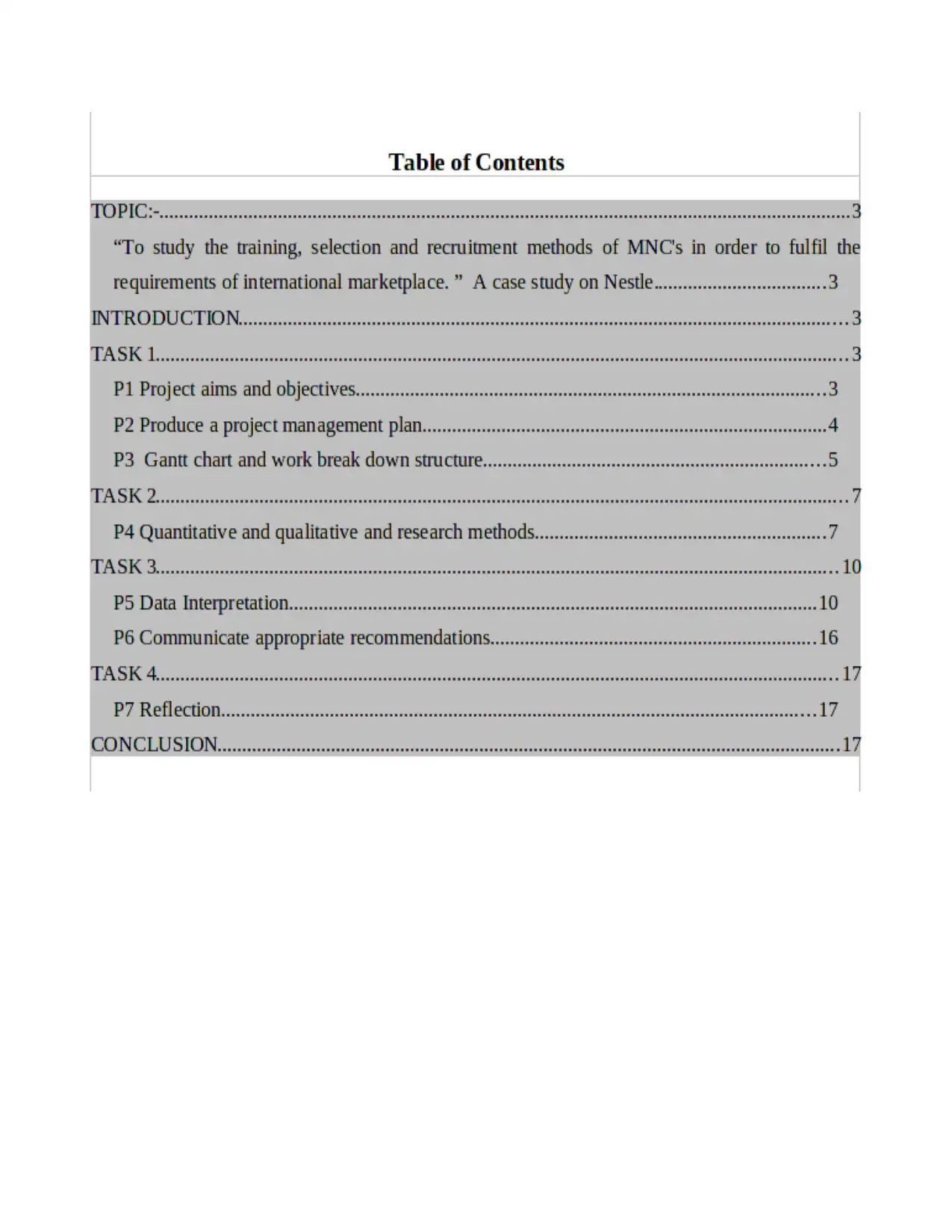
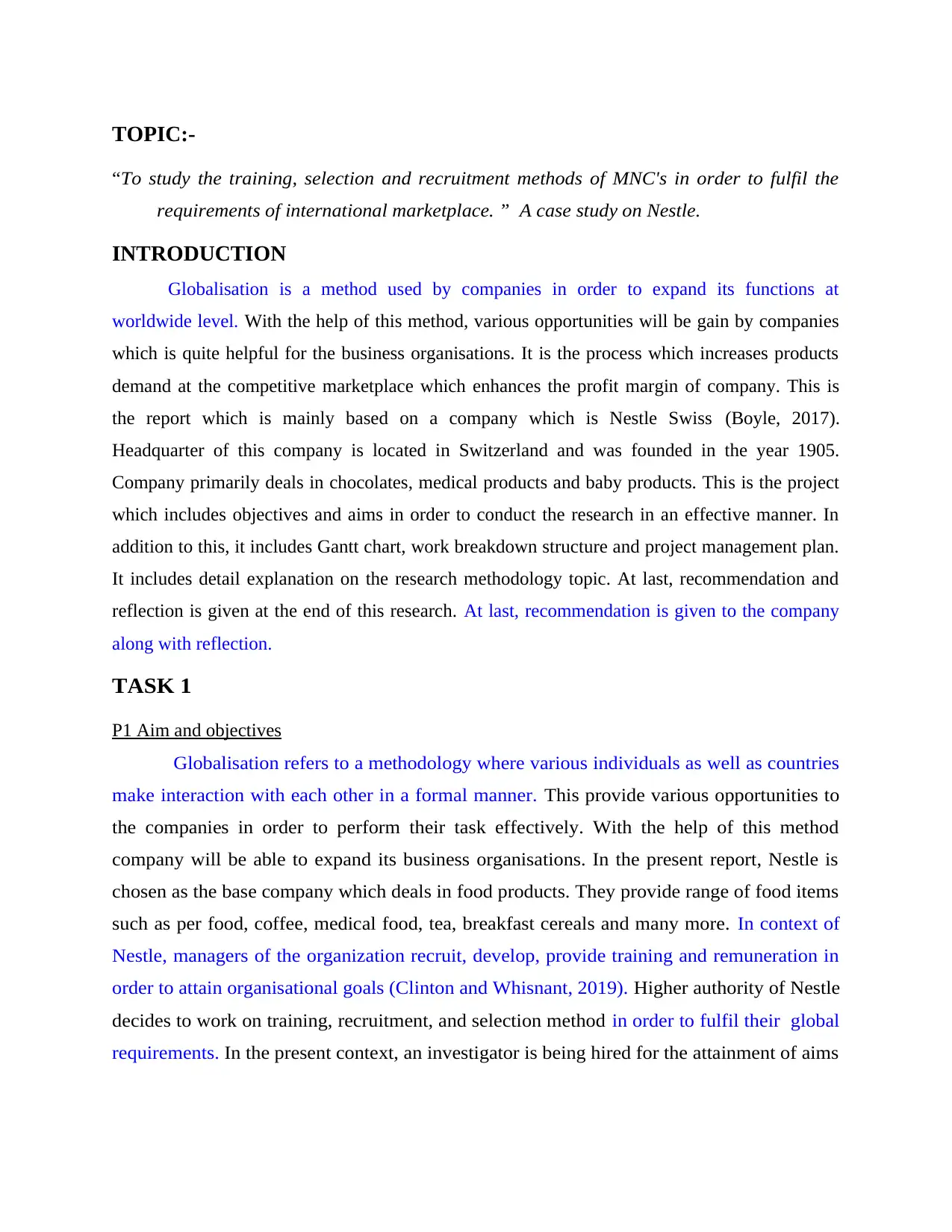
TOPIC:-
“To study the training, selection and recruitment methods of MNC's in order to fulfil the
requirements of international marketplace. ” A case study on Nestle.
INTRODUCTION
Globalisation is a method used by companies in order to expand its functions at
worldwide level. With the help of this method, various opportunities will be gain by companies
which is quite helpful for the business organisations. It is the process which increases products
demand at the competitive marketplace which enhances the profit margin of company. This is
the report which is mainly based on a company which is Nestle Swiss (Boyle, 2017).
Headquarter of this company is located in Switzerland and was founded in the year 1905.
Company primarily deals in chocolates, medical products and baby products. This is the project
which includes objectives and aims in order to conduct the research in an effective manner. In
addition to this, it includes Gantt chart, work breakdown structure and project management plan.
It includes detail explanation on the research methodology topic. At last, recommendation and
reflection is given at the end of this research. At last, recommendation is given to the company
along with reflection.
TASK 1
P1 Aim and objectives
Globalisation refers to a methodology where various individuals as well as countries
make interaction with each other in a formal manner. This provide various opportunities to
the companies in order to perform their task effectively. With the help of this method
company will be able to expand its business organisations. In the present report, Nestle is
chosen as the base company which deals in food products. They provide range of food items
such as per food, coffee, medical food, tea, breakfast cereals and many more. In context of
Nestle, managers of the organization recruit, develop, provide training and remuneration in
order to attain organisational goals (Clinton and Whisnant, 2019). Higher authority of Nestle
decides to work on training, recruitment, and selection method in order to fulfil their global
requirements. In the present context, an investigator is being hired for the attainment of aims
“To study the training, selection and recruitment methods of MNC's in order to fulfil the
requirements of international marketplace. ” A case study on Nestle.
INTRODUCTION
Globalisation is a method used by companies in order to expand its functions at
worldwide level. With the help of this method, various opportunities will be gain by companies
which is quite helpful for the business organisations. It is the process which increases products
demand at the competitive marketplace which enhances the profit margin of company. This is
the report which is mainly based on a company which is Nestle Swiss (Boyle, 2017).
Headquarter of this company is located in Switzerland and was founded in the year 1905.
Company primarily deals in chocolates, medical products and baby products. This is the project
which includes objectives and aims in order to conduct the research in an effective manner. In
addition to this, it includes Gantt chart, work breakdown structure and project management plan.
It includes detail explanation on the research methodology topic. At last, recommendation and
reflection is given at the end of this research. At last, recommendation is given to the company
along with reflection.
TASK 1
P1 Aim and objectives
Globalisation refers to a methodology where various individuals as well as countries
make interaction with each other in a formal manner. This provide various opportunities to
the companies in order to perform their task effectively. With the help of this method
company will be able to expand its business organisations. In the present report, Nestle is
chosen as the base company which deals in food products. They provide range of food items
such as per food, coffee, medical food, tea, breakfast cereals and many more. In context of
Nestle, managers of the organization recruit, develop, provide training and remuneration in
order to attain organisational goals (Clinton and Whisnant, 2019). Higher authority of Nestle
decides to work on training, recruitment, and selection method in order to fulfil their global
requirements. In the present context, an investigator is being hired for the attainment of aims
⊘ This is a preview!⊘
Do you want full access?
Subscribe today to unlock all pages.

Trusted by 1+ million students worldwide
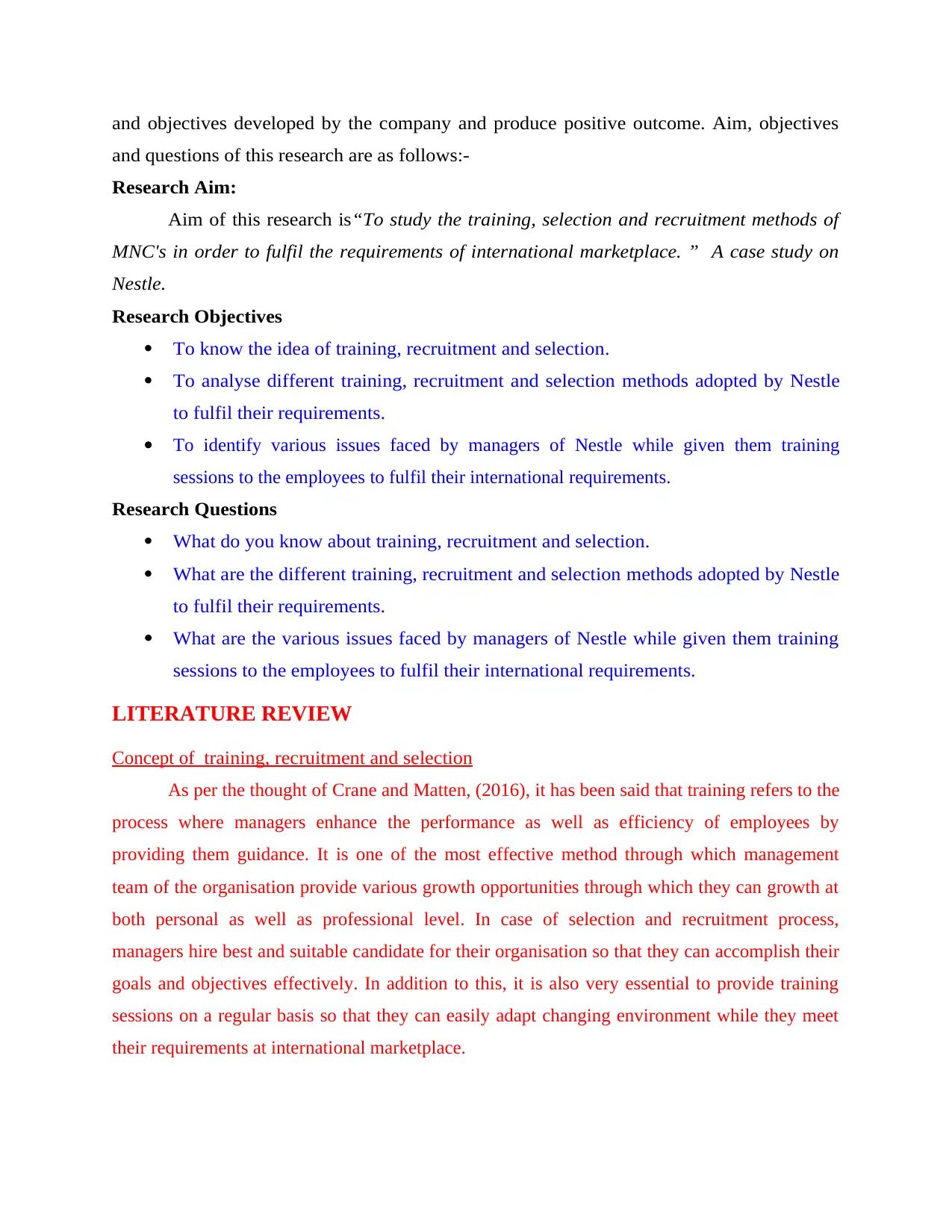
and objectives developed by the company and produce positive outcome. Aim, objectives
and questions of this research are as follows:-
Research Aim:
Aim of this research is“To study the training, selection and recruitment methods of
MNC's in order to fulfil the requirements of international marketplace. ” A case study on
Nestle.
Research Objectives
To know the idea of training, recruitment and selection.
To analyse different training, recruitment and selection methods adopted by Nestle
to fulfil their requirements.
To identify various issues faced by managers of Nestle while given them training
sessions to the employees to fulfil their international requirements.
Research Questions
What do you know about training, recruitment and selection.
What are the different training, recruitment and selection methods adopted by Nestle
to fulfil their requirements.
What are the various issues faced by managers of Nestle while given them training
sessions to the employees to fulfil their international requirements.
LITERATURE REVIEW
Concept of training, recruitment and selection
As per the thought of Crane and Matten, (2016), it has been said that training refers to the
process where managers enhance the performance as well as efficiency of employees by
providing them guidance. It is one of the most effective method through which management
team of the organisation provide various growth opportunities through which they can growth at
both personal as well as professional level. In case of selection and recruitment process,
managers hire best and suitable candidate for their organisation so that they can accomplish their
goals and objectives effectively. In addition to this, it is also very essential to provide training
sessions on a regular basis so that they can easily adapt changing environment while they meet
their requirements at international marketplace.
and questions of this research are as follows:-
Research Aim:
Aim of this research is“To study the training, selection and recruitment methods of
MNC's in order to fulfil the requirements of international marketplace. ” A case study on
Nestle.
Research Objectives
To know the idea of training, recruitment and selection.
To analyse different training, recruitment and selection methods adopted by Nestle
to fulfil their requirements.
To identify various issues faced by managers of Nestle while given them training
sessions to the employees to fulfil their international requirements.
Research Questions
What do you know about training, recruitment and selection.
What are the different training, recruitment and selection methods adopted by Nestle
to fulfil their requirements.
What are the various issues faced by managers of Nestle while given them training
sessions to the employees to fulfil their international requirements.
LITERATURE REVIEW
Concept of training, recruitment and selection
As per the thought of Crane and Matten, (2016), it has been said that training refers to the
process where managers enhance the performance as well as efficiency of employees by
providing them guidance. It is one of the most effective method through which management
team of the organisation provide various growth opportunities through which they can growth at
both personal as well as professional level. In case of selection and recruitment process,
managers hire best and suitable candidate for their organisation so that they can accomplish their
goals and objectives effectively. In addition to this, it is also very essential to provide training
sessions on a regular basis so that they can easily adapt changing environment while they meet
their requirements at international marketplace.
Paraphrase This Document
Need a fresh take? Get an instant paraphrase of this document with our AI Paraphraser
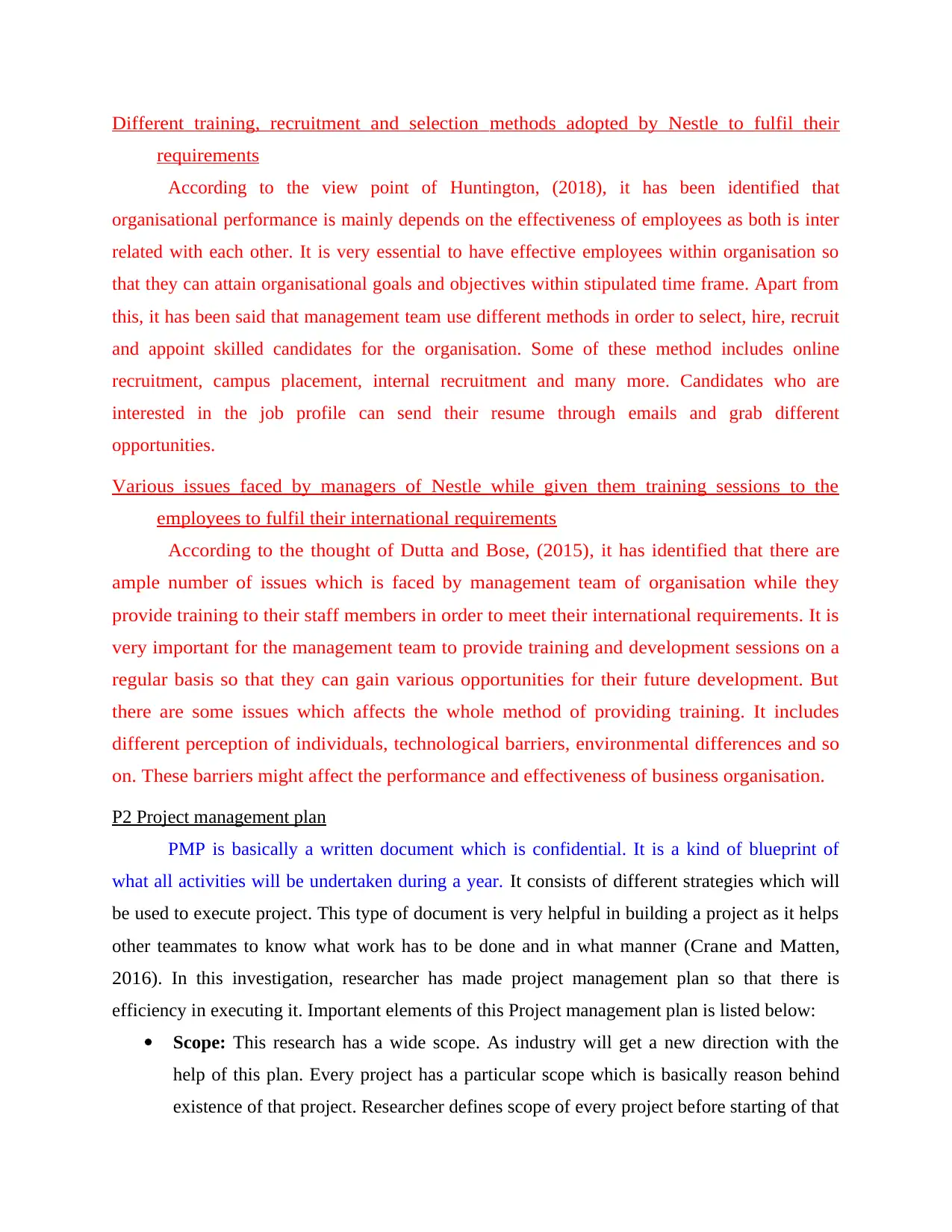
Different training, recruitment and selection methods adopted by Nestle to fulfil their
requirements
According to the view point of Huntington, (2018) , it has been identified that
organisational performance is mainly depends on the effectiveness of employees as both is inter
related with each other. It is very essential to have effective employees within organisation so
that they can attain organisational goals and objectives within stipulated time frame. Apart from
this, it has been said that management team use different methods in order to select, hire, recruit
and appoint skilled candidates for the organisation. Some of these method includes online
recruitment, campus placement, internal recruitment and many more. Candidates who are
interested in the job profile can send their resume through emails and grab different
opportunities.
Various issues faced by managers of Nestle while given them training sessions to the
employees to fulfil their international requirements
According to the thought of Dutta and Bose, (2015), it has identified that there are
ample number of issues which is faced by management team of organisation while they
provide training to their staff members in order to meet their international requirements. It is
very important for the management team to provide training and development sessions on a
regular basis so that they can gain various opportunities for their future development. But
there are some issues which affects the whole method of providing training. It includes
different perception of individuals, technological barriers, environmental differences and so
on. These barriers might affect the performance and effectiveness of business organisation.
P2 Project management plan
PMP is basically a written document which is confidential. It is a kind of blueprint of
what all activities will be undertaken during a year. It consists of different strategies which will
be used to execute project. This type of document is very helpful in building a project as it helps
other teammates to know what work has to be done and in what manner (Crane and Matten,
2016). In this investigation, researcher has made project management plan so that there is
efficiency in executing it. Important elements of this Project management plan is listed below:
Scope: This research has a wide scope. As industry will get a new direction with the
help of this plan. Every project has a particular scope which is basically reason behind
existence of that project. Researcher defines scope of every project before starting of that
requirements
According to the view point of Huntington, (2018) , it has been identified that
organisational performance is mainly depends on the effectiveness of employees as both is inter
related with each other. It is very essential to have effective employees within organisation so
that they can attain organisational goals and objectives within stipulated time frame. Apart from
this, it has been said that management team use different methods in order to select, hire, recruit
and appoint skilled candidates for the organisation. Some of these method includes online
recruitment, campus placement, internal recruitment and many more. Candidates who are
interested in the job profile can send their resume through emails and grab different
opportunities.
Various issues faced by managers of Nestle while given them training sessions to the
employees to fulfil their international requirements
According to the thought of Dutta and Bose, (2015), it has identified that there are
ample number of issues which is faced by management team of organisation while they
provide training to their staff members in order to meet their international requirements. It is
very important for the management team to provide training and development sessions on a
regular basis so that they can gain various opportunities for their future development. But
there are some issues which affects the whole method of providing training. It includes
different perception of individuals, technological barriers, environmental differences and so
on. These barriers might affect the performance and effectiveness of business organisation.
P2 Project management plan
PMP is basically a written document which is confidential. It is a kind of blueprint of
what all activities will be undertaken during a year. It consists of different strategies which will
be used to execute project. This type of document is very helpful in building a project as it helps
other teammates to know what work has to be done and in what manner (Crane and Matten,
2016). In this investigation, researcher has made project management plan so that there is
efficiency in executing it. Important elements of this Project management plan is listed below:
Scope: This research has a wide scope. As industry will get a new direction with the
help of this plan. Every project has a particular scope which is basically reason behind
existence of that project. Researcher defines scope of every project before starting of that
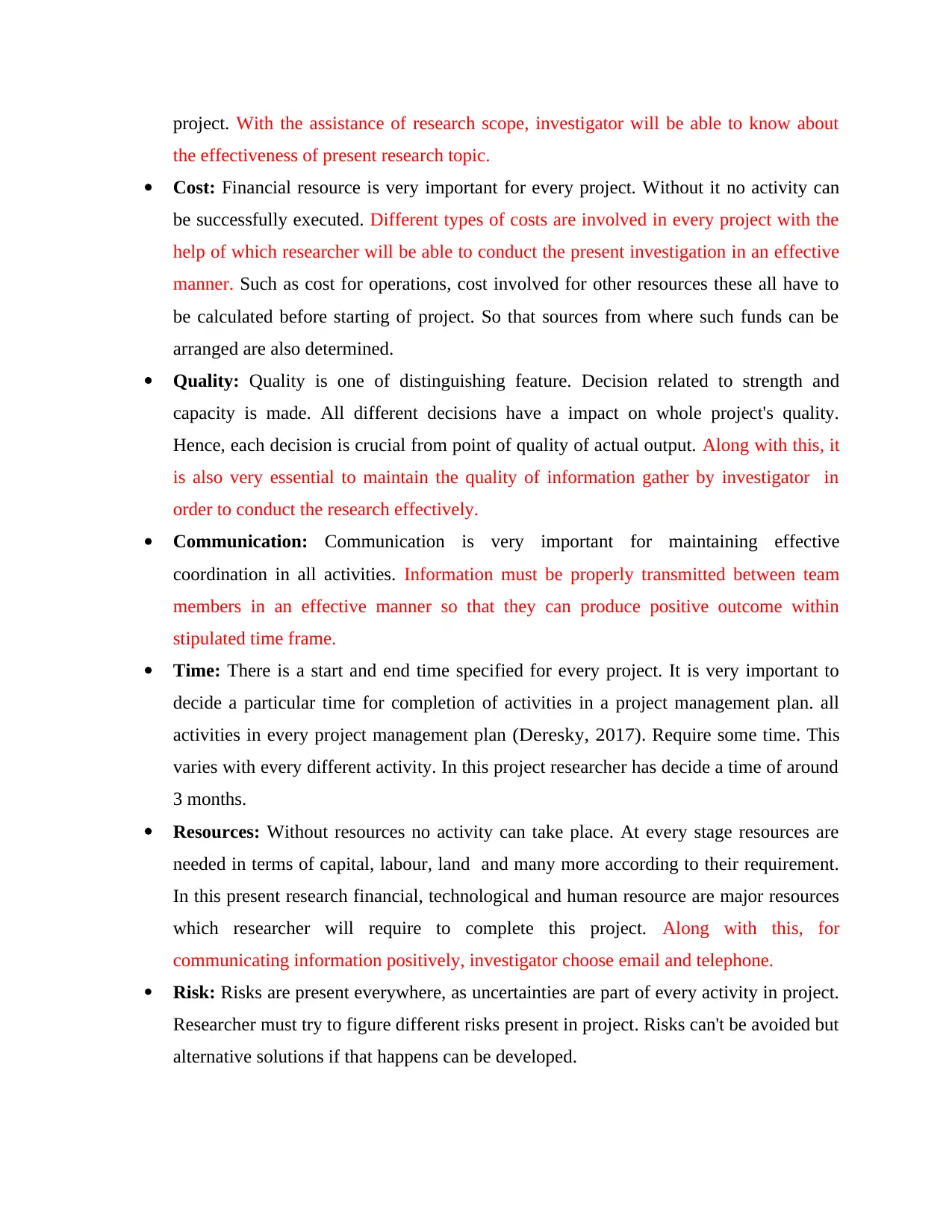
project. With the assistance of research scope, investigator will be able to know about
the effectiveness of present research topic.
Cost: Financial resource is very important for every project. Without it no activity can
be successfully executed. Different types of costs are involved in every project with the
help of which researcher will be able to conduct the present investigation in an effective
manner. Such as cost for operations, cost involved for other resources these all have to
be calculated before starting of project. So that sources from where such funds can be
arranged are also determined.
Quality: Quality is one of distinguishing feature. Decision related to strength and
capacity is made. All different decisions have a impact on whole project's quality.
Hence, each decision is crucial from point of quality of actual output. Along with this, it
is also very essential to maintain the quality of information gather by investigator in
order to conduct the research effectively.
Communication: Communication is very important for maintaining effective
coordination in all activities. Information must be properly transmitted between team
members in an effective manner so that they can produce positive outcome within
stipulated time frame.
Time: There is a start and end time specified for every project. It is very important to
decide a particular time for completion of activities in a project management plan. all
activities in every project management plan (Deresky, 2017). Require some time. This
varies with every different activity. In this project researcher has decide a time of around
3 months.
Resources: Without resources no activity can take place. At every stage resources are
needed in terms of capital, labour, land and many more according to their requirement.
In this present research financial, technological and human resource are major resources
which researcher will require to complete this project. Along with this, for
communicating information positively, investigator choose email and telephone.
Risk: Risks are present everywhere, as uncertainties are part of every activity in project.
Researcher must try to figure different risks present in project. Risks can't be avoided but
alternative solutions if that happens can be developed.
the effectiveness of present research topic.
Cost: Financial resource is very important for every project. Without it no activity can
be successfully executed. Different types of costs are involved in every project with the
help of which researcher will be able to conduct the present investigation in an effective
manner. Such as cost for operations, cost involved for other resources these all have to
be calculated before starting of project. So that sources from where such funds can be
arranged are also determined.
Quality: Quality is one of distinguishing feature. Decision related to strength and
capacity is made. All different decisions have a impact on whole project's quality.
Hence, each decision is crucial from point of quality of actual output. Along with this, it
is also very essential to maintain the quality of information gather by investigator in
order to conduct the research effectively.
Communication: Communication is very important for maintaining effective
coordination in all activities. Information must be properly transmitted between team
members in an effective manner so that they can produce positive outcome within
stipulated time frame.
Time: There is a start and end time specified for every project. It is very important to
decide a particular time for completion of activities in a project management plan. all
activities in every project management plan (Deresky, 2017). Require some time. This
varies with every different activity. In this project researcher has decide a time of around
3 months.
Resources: Without resources no activity can take place. At every stage resources are
needed in terms of capital, labour, land and many more according to their requirement.
In this present research financial, technological and human resource are major resources
which researcher will require to complete this project. Along with this, for
communicating information positively, investigator choose email and telephone.
Risk: Risks are present everywhere, as uncertainties are part of every activity in project.
Researcher must try to figure different risks present in project. Risks can't be avoided but
alternative solutions if that happens can be developed.
⊘ This is a preview!⊘
Do you want full access?
Subscribe today to unlock all pages.

Trusted by 1+ million students worldwide
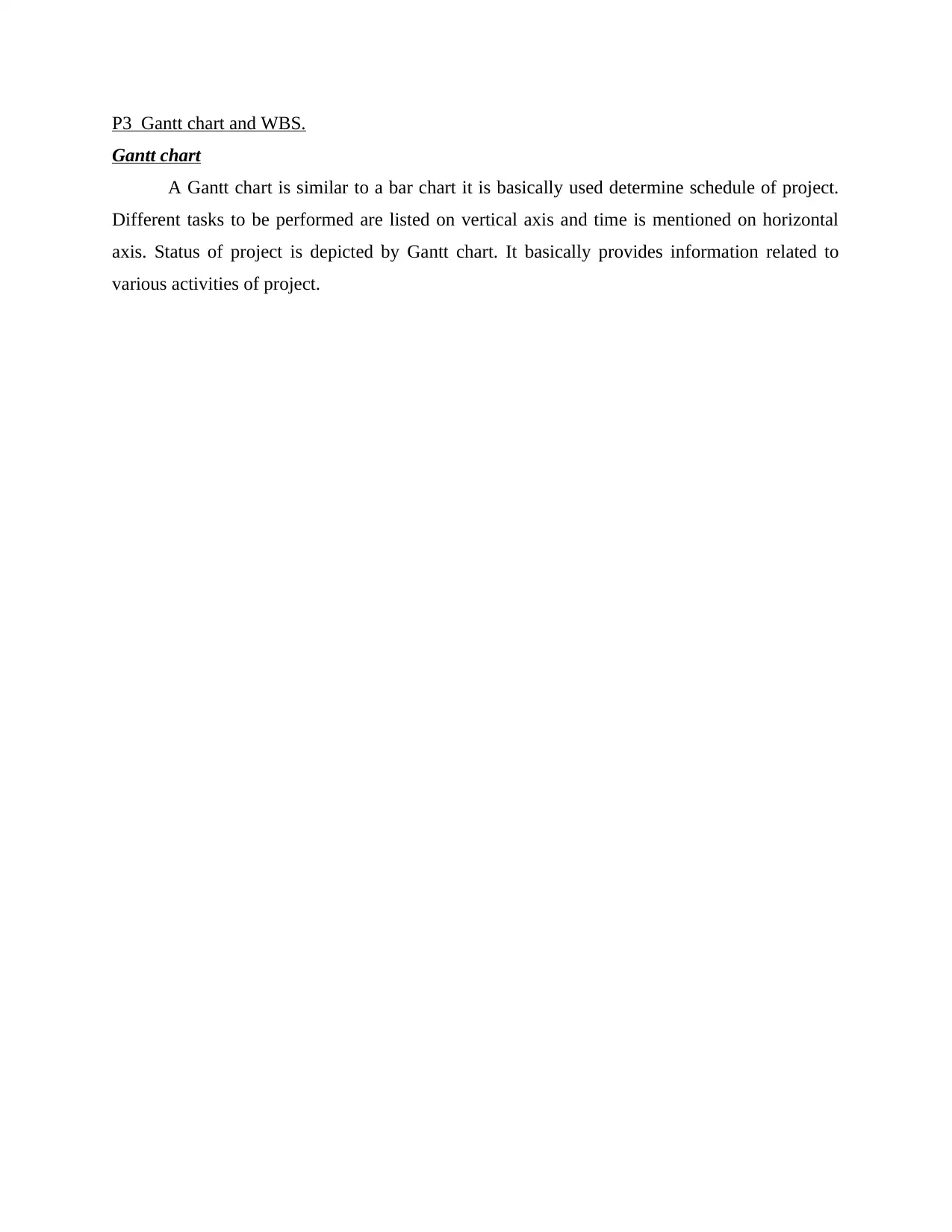
P3 Gantt chart and WBS.
Gantt chart
A Gantt chart is similar to a bar chart it is basically used determine schedule of project.
Different tasks to be performed are listed on vertical axis and time is mentioned on horizontal
axis. Status of project is depicted by Gantt chart. It basically provides information related to
various activities of project.
Gantt chart
A Gantt chart is similar to a bar chart it is basically used determine schedule of project.
Different tasks to be performed are listed on vertical axis and time is mentioned on horizontal
axis. Status of project is depicted by Gantt chart. It basically provides information related to
various activities of project.
Paraphrase This Document
Need a fresh take? Get an instant paraphrase of this document with our AI Paraphraser
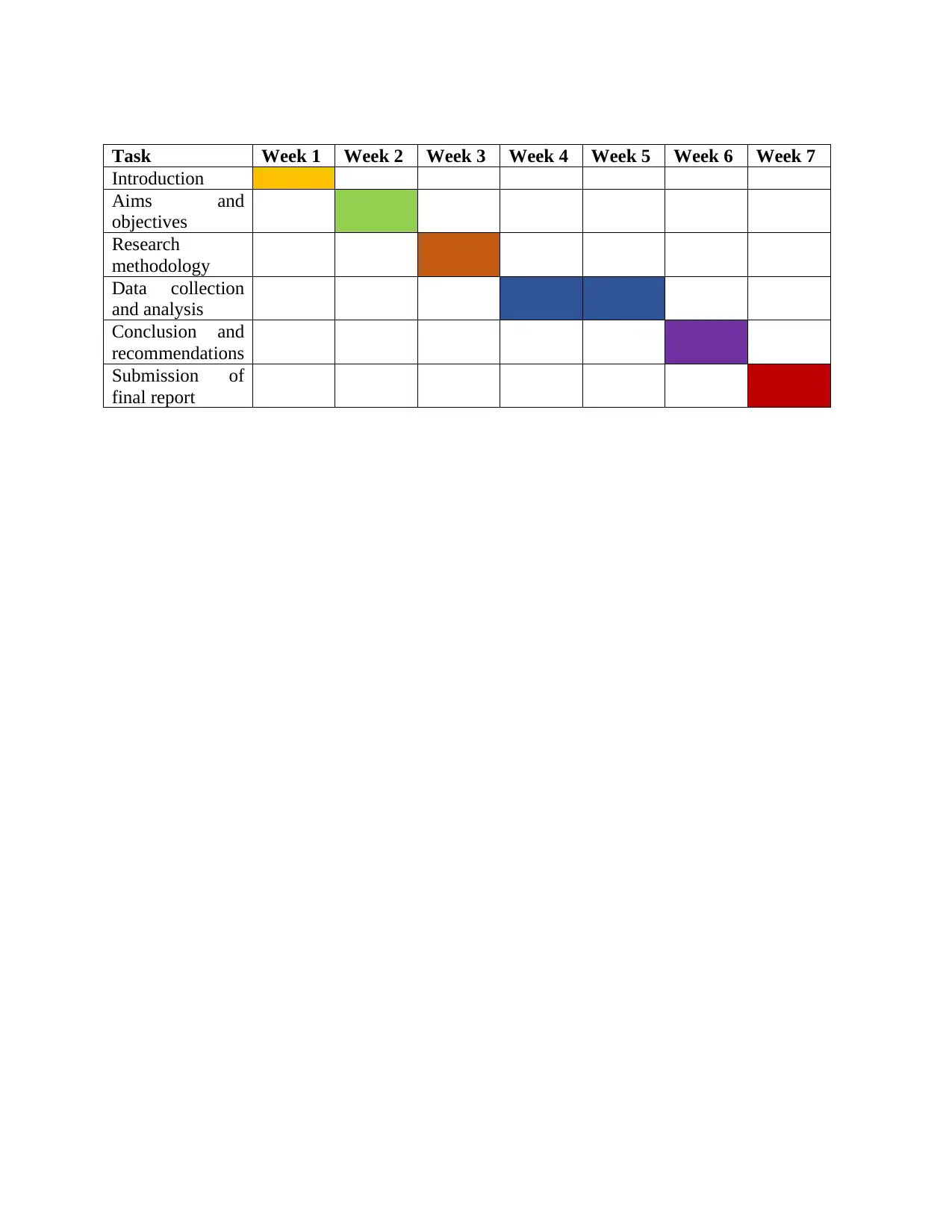
Task Week 1 Week 2 Week 3 Week 4 Week 5 Week 6 Week 7
Introduction
Aims and
objectives
Research
methodology
Data collection
and analysis
Conclusion and
recommendations
Submission of
final report
Introduction
Aims and
objectives
Research
methodology
Data collection
and analysis
Conclusion and
recommendations
Submission of
final report
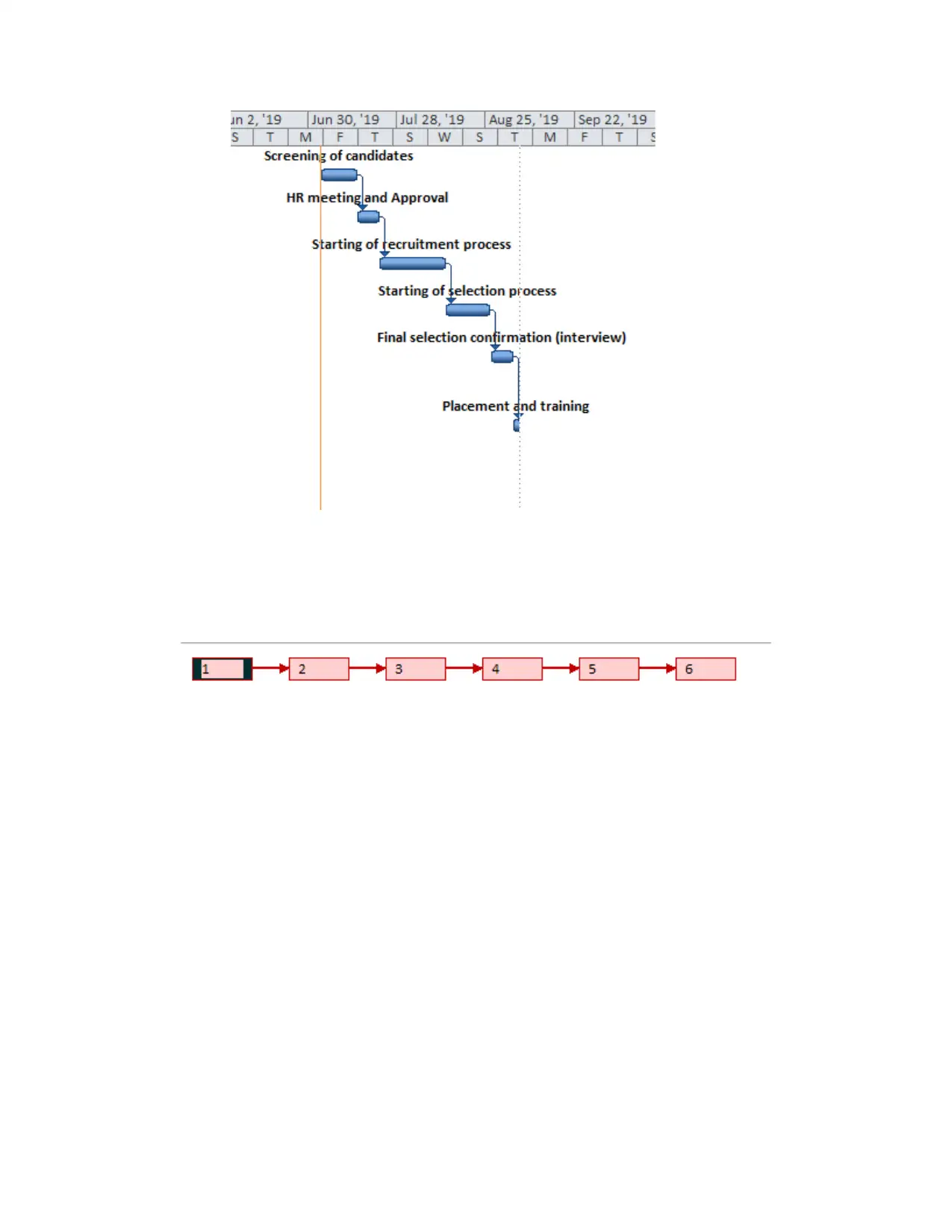
⊘ This is a preview!⊘
Do you want full access?
Subscribe today to unlock all pages.

Trusted by 1+ million students worldwide
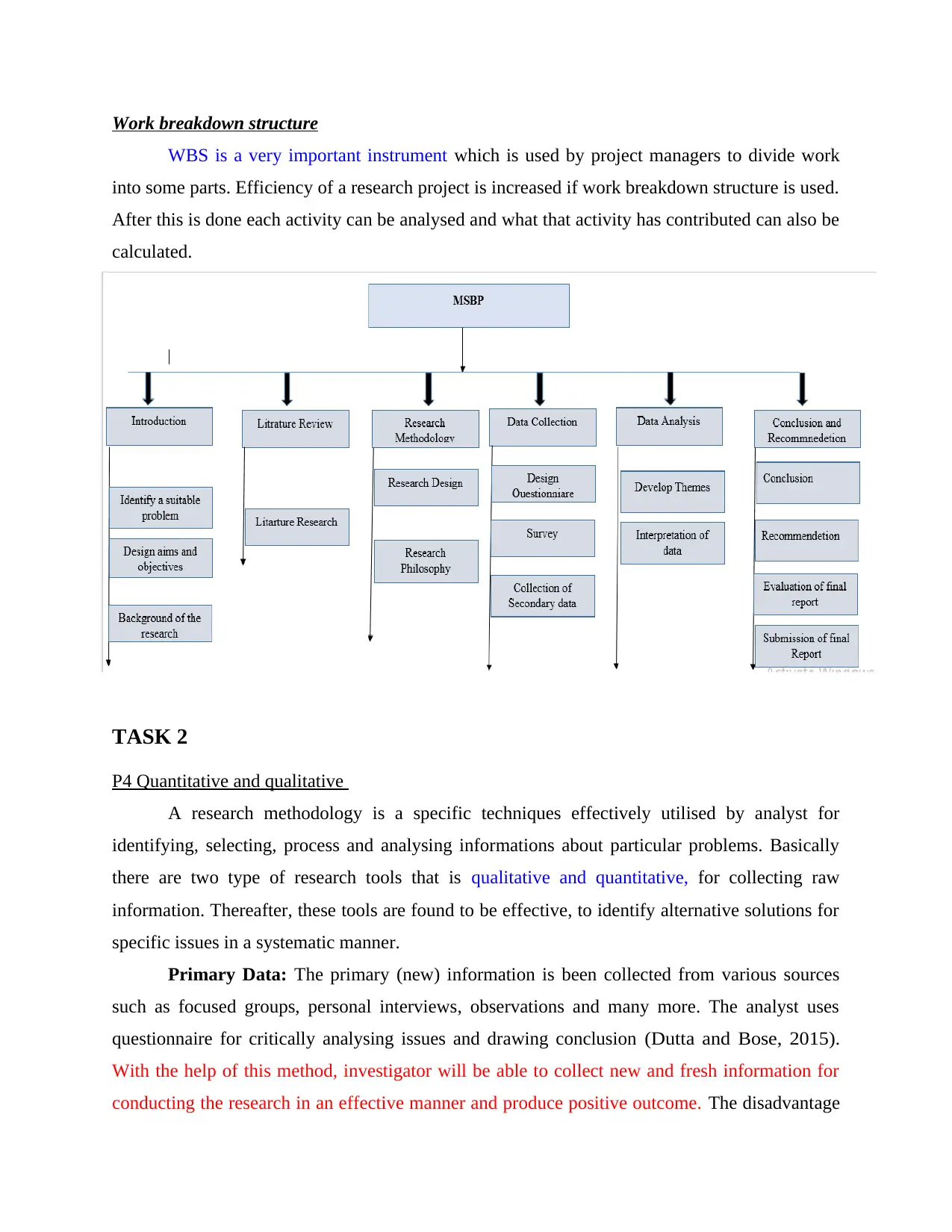
Work breakdown structure
WBS is a very important instrument which is used by project managers to divide work
into some parts. Efficiency of a research project is increased if work breakdown structure is used.
After this is done each activity can be analysed and what that activity has contributed can also be
calculated.
TASK 2
P4 Quantitative and qualitative
A research methodology is a specific techniques effectively utilised by analyst for
identifying, selecting, process and analysing informations about particular problems. Basically
there are two type of research tools that is qualitative and quantitative, for collecting raw
information. Thereafter, these tools are found to be effective, to identify alternative solutions for
specific issues in a systematic manner.
Primary Data: The primary (new) information is been collected from various sources
such as focused groups, personal interviews, observations and many more. The analyst uses
questionnaire for critically analysing issues and drawing conclusion (Dutta and Bose, 2015).
With the help of this method, investigator will be able to collect new and fresh information for
conducting the research in an effective manner and produce positive outcome. The disadvantage
WBS is a very important instrument which is used by project managers to divide work
into some parts. Efficiency of a research project is increased if work breakdown structure is used.
After this is done each activity can be analysed and what that activity has contributed can also be
calculated.
TASK 2
P4 Quantitative and qualitative
A research methodology is a specific techniques effectively utilised by analyst for
identifying, selecting, process and analysing informations about particular problems. Basically
there are two type of research tools that is qualitative and quantitative, for collecting raw
information. Thereafter, these tools are found to be effective, to identify alternative solutions for
specific issues in a systematic manner.
Primary Data: The primary (new) information is been collected from various sources
such as focused groups, personal interviews, observations and many more. The analyst uses
questionnaire for critically analysing issues and drawing conclusion (Dutta and Bose, 2015).
With the help of this method, investigator will be able to collect new and fresh information for
conducting the research in an effective manner and produce positive outcome. The disadvantage
Paraphrase This Document
Need a fresh take? Get an instant paraphrase of this document with our AI Paraphraser
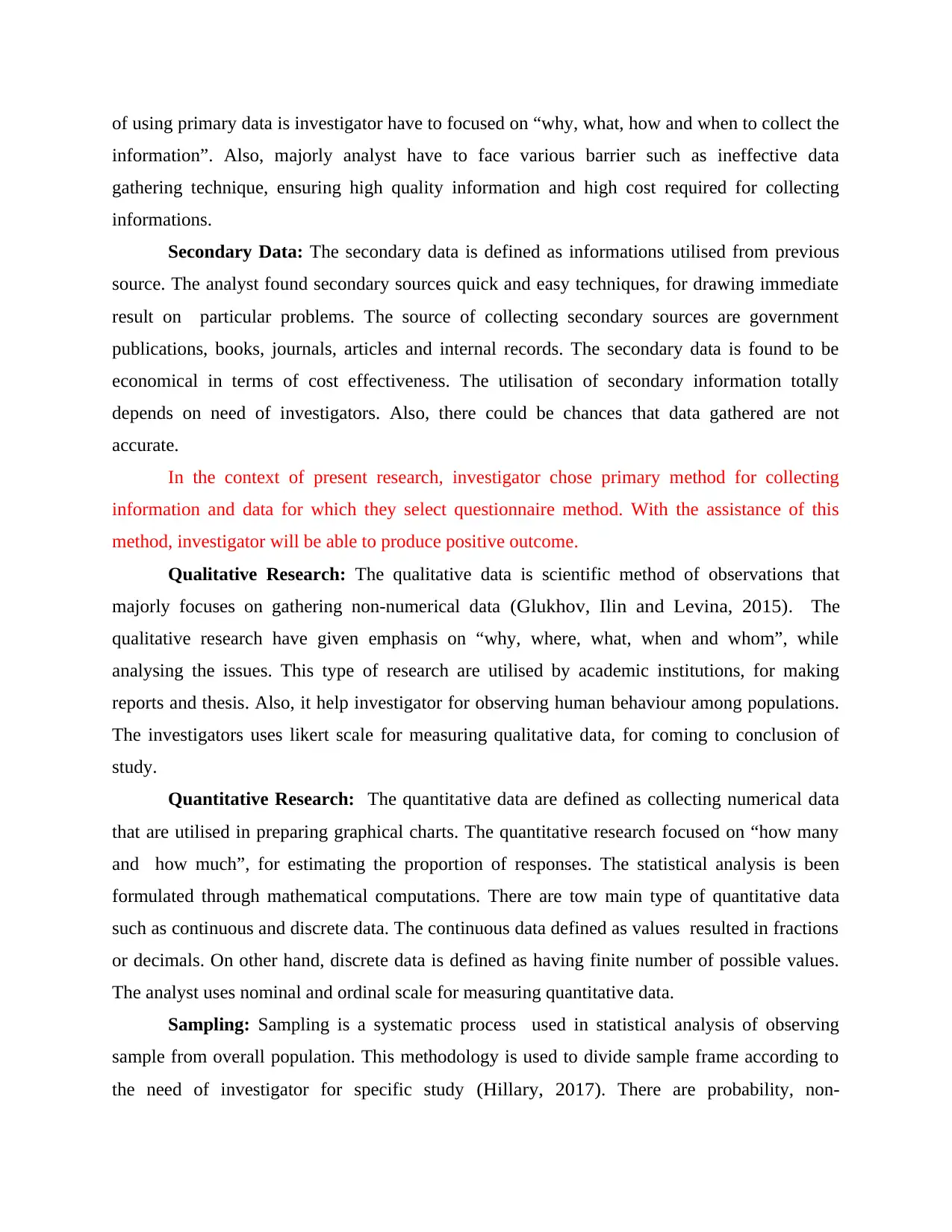
of using primary data is investigator have to focused on “why, what, how and when to collect the
information”. Also, majorly analyst have to face various barrier such as ineffective data
gathering technique, ensuring high quality information and high cost required for collecting
informations.
Secondary Data: The secondary data is defined as informations utilised from previous
source. The analyst found secondary sources quick and easy techniques, for drawing immediate
result on particular problems. The source of collecting secondary sources are government
publications, books, journals, articles and internal records. The secondary data is found to be
economical in terms of cost effectiveness. The utilisation of secondary information totally
depends on need of investigators. Also, there could be chances that data gathered are not
accurate.
In the context of present research, investigator chose primary method for collecting
information and data for which they select questionnaire method. With the assistance of this
method, investigator will be able to produce positive outcome.
Qualitative Research: The qualitative data is scientific method of observations that
majorly focuses on gathering non-numerical data (Glukhov, Ilin and Levina, 2015). The
qualitative research have given emphasis on “why, where, what, when and whom”, while
analysing the issues. This type of research are utilised by academic institutions, for making
reports and thesis. Also, it help investigator for observing human behaviour among populations.
The investigators uses likert scale for measuring qualitative data, for coming to conclusion of
study.
Quantitative Research: The quantitative data are defined as collecting numerical data
that are utilised in preparing graphical charts. The quantitative research focused on “how many
and how much”, for estimating the proportion of responses. The statistical analysis is been
formulated through mathematical computations. There are tow main type of quantitative data
such as continuous and discrete data. The continuous data defined as values resulted in fractions
or decimals. On other hand, discrete data is defined as having finite number of possible values.
The analyst uses nominal and ordinal scale for measuring quantitative data.
Sampling: Sampling is a systematic process used in statistical analysis of observing
sample from overall population. This methodology is used to divide sample frame according to
the need of investigator for specific study (Hillary, 2017). There are probability, non-
information”. Also, majorly analyst have to face various barrier such as ineffective data
gathering technique, ensuring high quality information and high cost required for collecting
informations.
Secondary Data: The secondary data is defined as informations utilised from previous
source. The analyst found secondary sources quick and easy techniques, for drawing immediate
result on particular problems. The source of collecting secondary sources are government
publications, books, journals, articles and internal records. The secondary data is found to be
economical in terms of cost effectiveness. The utilisation of secondary information totally
depends on need of investigators. Also, there could be chances that data gathered are not
accurate.
In the context of present research, investigator chose primary method for collecting
information and data for which they select questionnaire method. With the assistance of this
method, investigator will be able to produce positive outcome.
Qualitative Research: The qualitative data is scientific method of observations that
majorly focuses on gathering non-numerical data (Glukhov, Ilin and Levina, 2015). The
qualitative research have given emphasis on “why, where, what, when and whom”, while
analysing the issues. This type of research are utilised by academic institutions, for making
reports and thesis. Also, it help investigator for observing human behaviour among populations.
The investigators uses likert scale for measuring qualitative data, for coming to conclusion of
study.
Quantitative Research: The quantitative data are defined as collecting numerical data
that are utilised in preparing graphical charts. The quantitative research focused on “how many
and how much”, for estimating the proportion of responses. The statistical analysis is been
formulated through mathematical computations. There are tow main type of quantitative data
such as continuous and discrete data. The continuous data defined as values resulted in fractions
or decimals. On other hand, discrete data is defined as having finite number of possible values.
The analyst uses nominal and ordinal scale for measuring quantitative data.
Sampling: Sampling is a systematic process used in statistical analysis of observing
sample from overall population. This methodology is used to divide sample frame according to
the need of investigator for specific study (Hillary, 2017). There are probability, non-
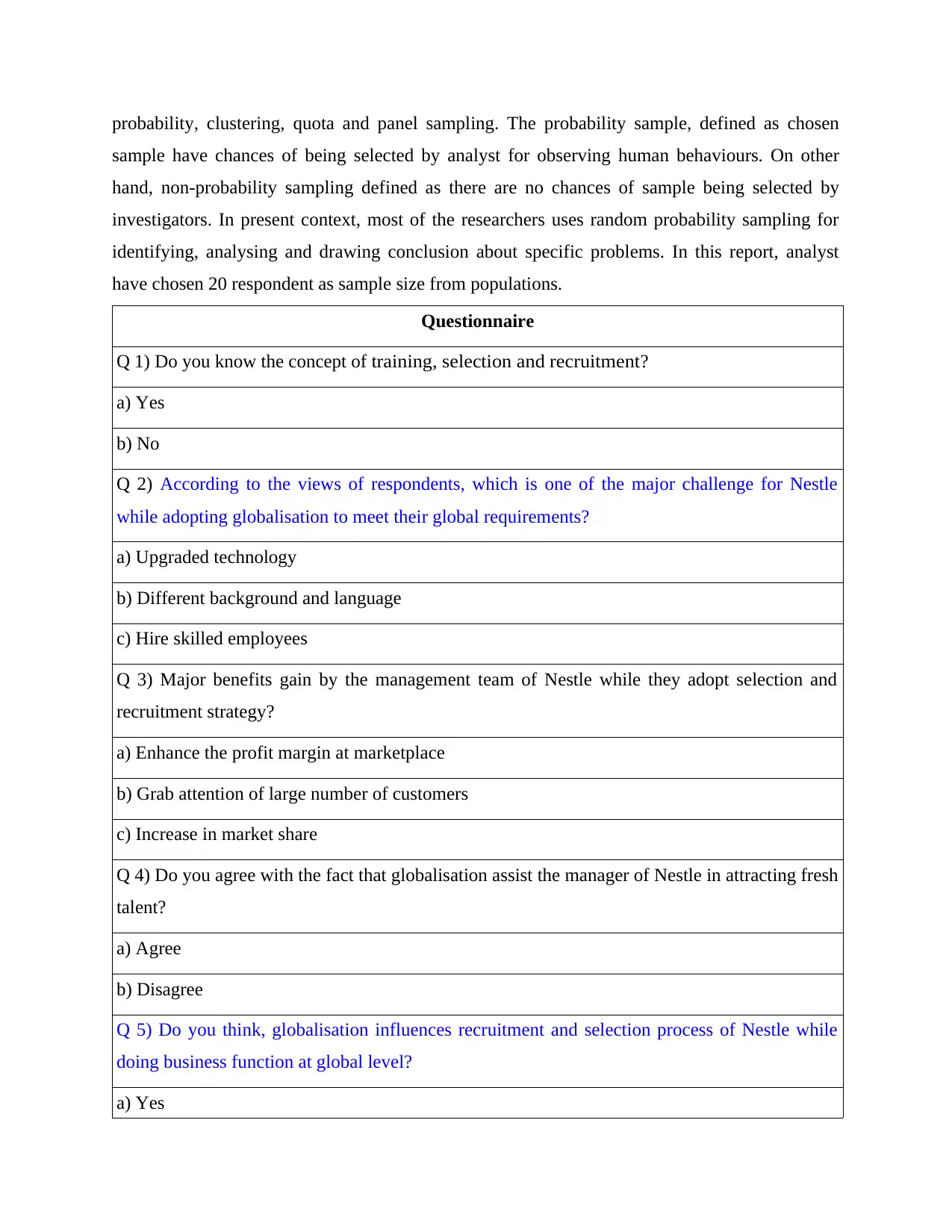
probability, clustering, quota and panel sampling. The probability sample, defined as chosen
sample have chances of being selected by analyst for observing human behaviours. On other
hand, non-probability sampling defined as there are no chances of sample being selected by
investigators. In present context, most of the researchers uses random probability sampling for
identifying, analysing and drawing conclusion about specific problems. In this report, analyst
have chosen 20 respondent as sample size from populations.
Questionnaire
Q 1) Do you know the concept of training, selection and recruitment?
a) Yes
b) No
Q 2) According to the views of respondents, which is one of the major challenge for Nestle
while adopting globalisation to meet their global requirements?
a) Upgraded technology
b) Different background and language
c) Hire skilled employees
Q 3) Major benefits gain by the management team of Nestle while they adopt selection and
recruitment strategy?
a) Enhance the profit margin at marketplace
b) Grab attention of large number of customers
c) Increase in market share
Q 4) Do you agree with the fact that globalisation assist the manager of Nestle in attracting fresh
talent?
a) Agree
b) Disagree
Q 5) Do you think, globalisation influences recruitment and selection process of Nestle while
doing business function at global level?
a) Yes
sample have chances of being selected by analyst for observing human behaviours. On other
hand, non-probability sampling defined as there are no chances of sample being selected by
investigators. In present context, most of the researchers uses random probability sampling for
identifying, analysing and drawing conclusion about specific problems. In this report, analyst
have chosen 20 respondent as sample size from populations.
Questionnaire
Q 1) Do you know the concept of training, selection and recruitment?
a) Yes
b) No
Q 2) According to the views of respondents, which is one of the major challenge for Nestle
while adopting globalisation to meet their global requirements?
a) Upgraded technology
b) Different background and language
c) Hire skilled employees
Q 3) Major benefits gain by the management team of Nestle while they adopt selection and
recruitment strategy?
a) Enhance the profit margin at marketplace
b) Grab attention of large number of customers
c) Increase in market share
Q 4) Do you agree with the fact that globalisation assist the manager of Nestle in attracting fresh
talent?
a) Agree
b) Disagree
Q 5) Do you think, globalisation influences recruitment and selection process of Nestle while
doing business function at global level?
a) Yes
⊘ This is a preview!⊘
Do you want full access?
Subscribe today to unlock all pages.

Trusted by 1+ million students worldwide
1 out of 30
Related Documents
Your All-in-One AI-Powered Toolkit for Academic Success.
+13062052269
info@desklib.com
Available 24*7 on WhatsApp / Email
![[object Object]](/_next/static/media/star-bottom.7253800d.svg)
Unlock your academic potential
Copyright © 2020–2025 A2Z Services. All Rights Reserved. Developed and managed by ZUCOL.





